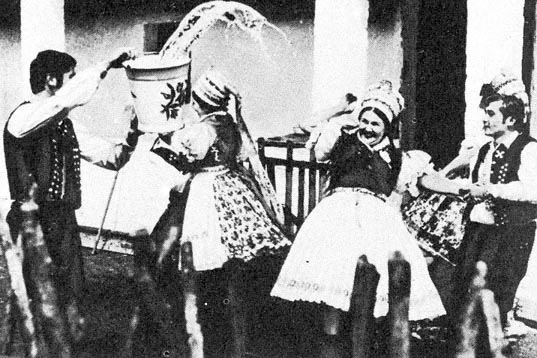Easter is one of the most important feasts of the Transylvanian Hungarian community. It is a so called moving feast, as it is celebrated every year on the Sunday that follows the first full moon that comes after the spring solstice. This way the earliest date of Easter would be the 22nd of March, whilst the latest the 25th of April. Transylvanian communities still practice various archaic Easter habits.
Easter time actually begins with Palm Sunday. In Transylvanian villages with communities belonging to the Reformed Church, the ordinance of confirmation was usually held on this date, in some places it still is.Ethnographers point out that in the structure of Easter one can find not only Christian elements, but there are some archaic custom items of the pagan era present as well. These were meant to greet the spring, and to attract, to charm fertility.
The most important habitual elements of the Easter feast in Transylvania are the so called Passion games that invoke the Passion of Christ, the consecration of fire, that of food and water, the symbolic usage of green branches, the habit of watering, the bestowal of eggs and the walking around the lands surrounding the settlement.
In medieval times, before the era of Reformation, mystery games invoking the life story of Jesus Christ were presented in every catholic church and cloister. In catholic Transylvanian villages some elements of the more complex medieval Passion games are still practiced, like the guarding of the symbolic Holy Sepulcher. Young men acting as roman soldiers protect the grave of Christ from the day of Good Friday until the Resurrection procession performed on the night of Holy Saturday. Many old women, and in some places quite a few members of the community keep vigil on Good Friday night.
In some catholic villages of the Székelyföld (Szeklerland, Ţara Secuilor), mostly in the Felcsík region, people put handkerchief-decorated pines nearby crosses or in front of churches, destined for Jesus, just as it is customary in the memory of young men who die before marriage.
The consecration of fire, food and water is as well practiced in catholic communities, and the custom has its roots in pagan times. The ritual is meant to assure the health of the family, of the community. People bring the specific dishes of the Easter lunch to the priest, who blesses these. Even the crumbs of the consecrated food are valuable, as these are used in the summer to chase away mischievous sparrows.

It is believed that water used at the Easter ritual purifies and ensures fertility, youth and beauty
Source: mek.oszk.hu
Walking round the territories is ever still an element of Transylvanian Easter customs. According to ethnographers, in older times people were convinced that if they circle around a certain part of land in a specific moment and amongst specific conditions, this would protect the territory from calamities, harmful animals or different entities with supernatural powers.
In several Transylvanian villages young men give girls green branches on the dawn of Easter Sunday. In some places the branch of the birch tree or pine is decorated with colored stripes and eggs as well. This gift is used in other customs related to spring as well, for instance in May, when it becomes the “maypole”. In any case, it is believed, that the green branches grant good health and beauty to the girl who receive them.
The liveliest custom of the feast is the watering of girls, and the bestowal of the colorful, usually beautifully decorated Easter eggs that girls give to young men. Nowadays in many places men use only perfume for the Easter watering, but the original custom naturally implies the usage of water. Eggs and water as well symbolize the essence of life and fertility.
Title Image: Easter eggs are decorated using all kinds of techniques, and still are the symbol of the renewal of life
Source:jelesnapok.oszk.hu